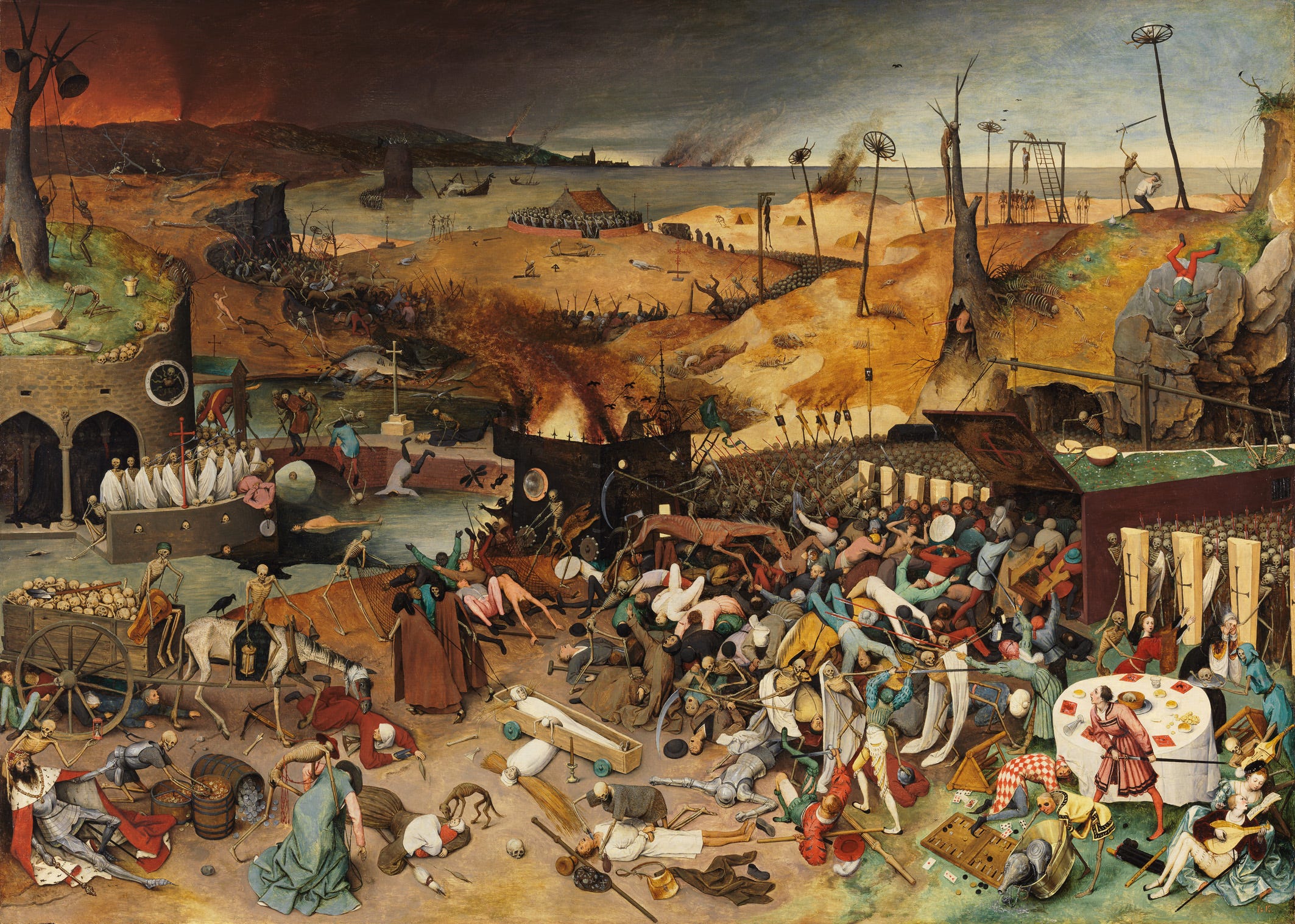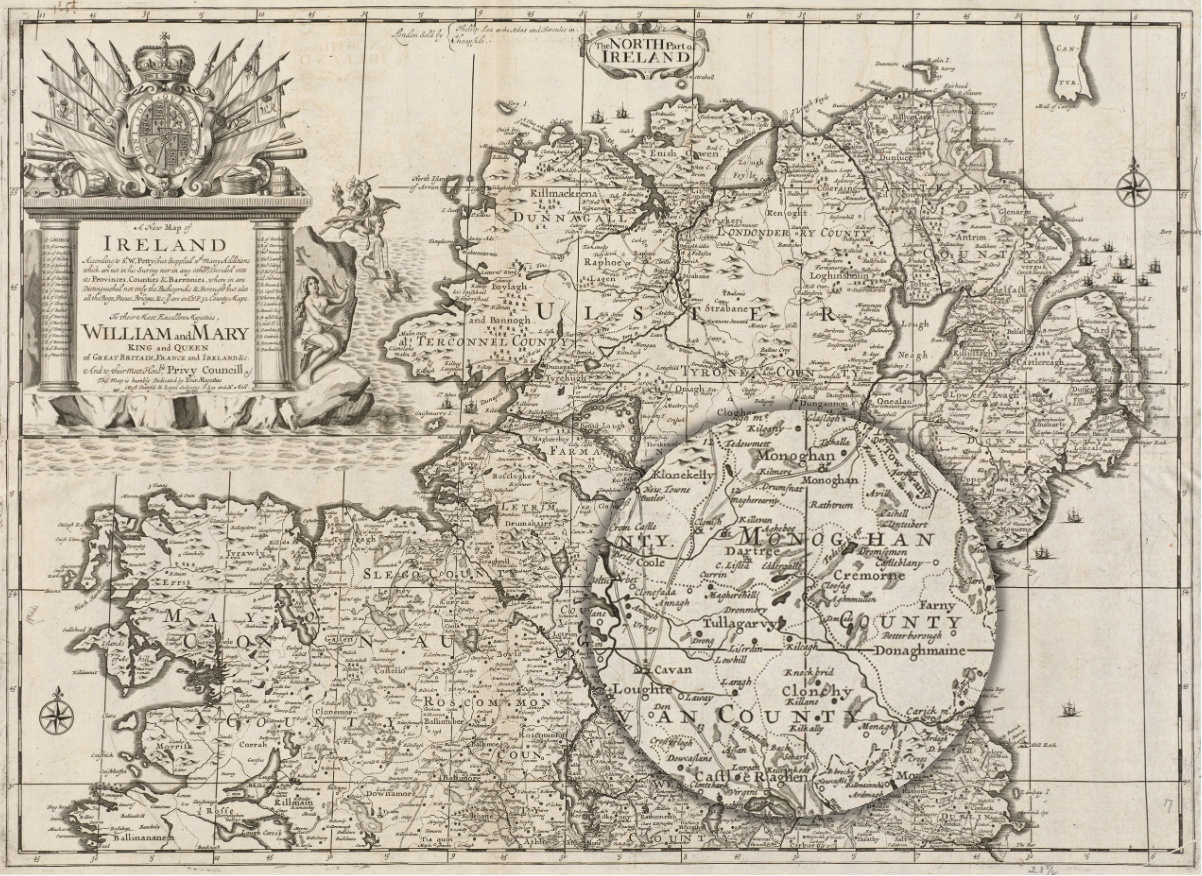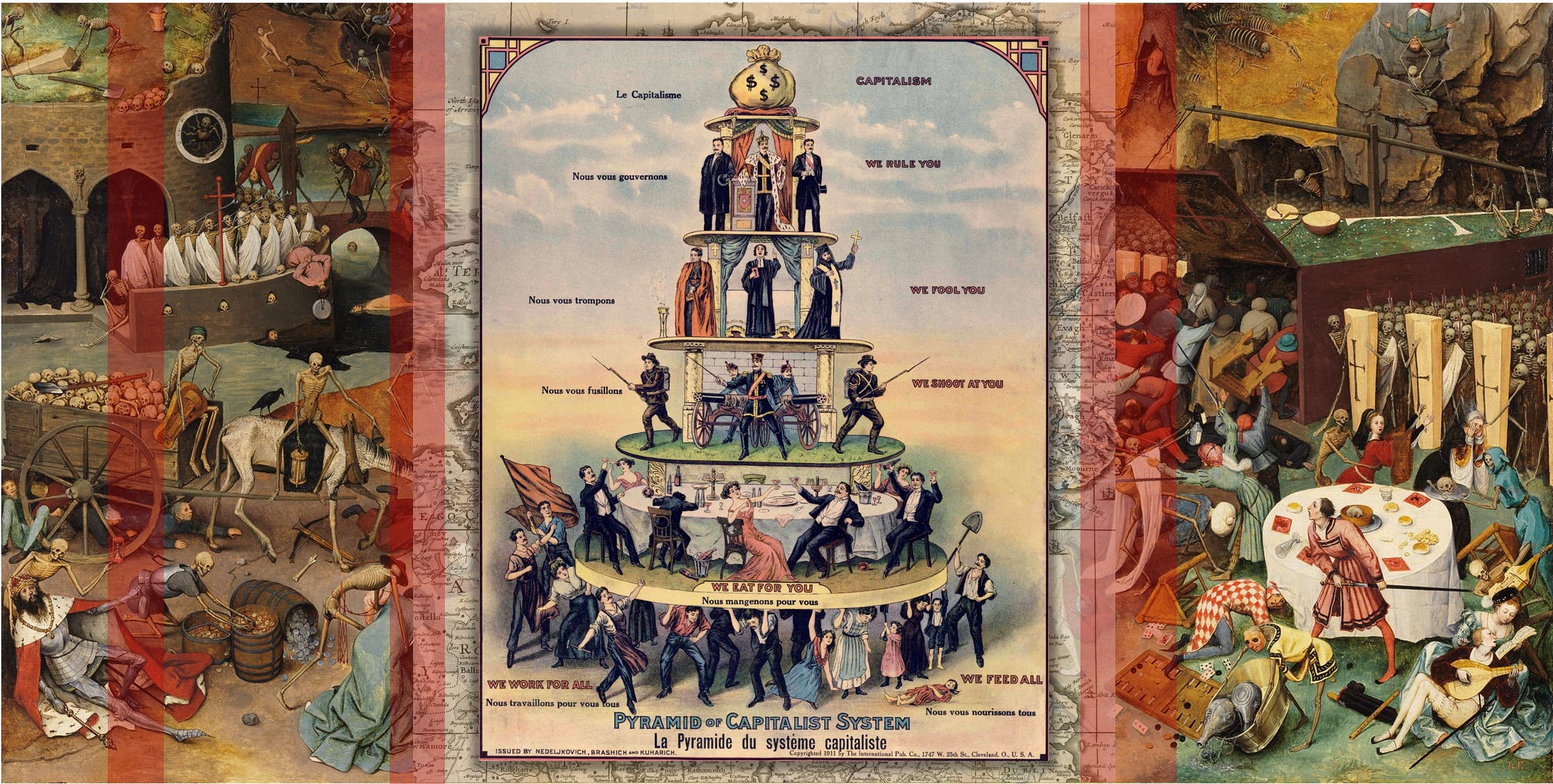Hello Interactors,
Fall is in full swing here in the northern hemisphere, which means it’s time to turn our attention to economics and economic geography. Triggered by a recent podcast on the origins of capitalism, I thought I’d kick off by exploring this from a geography perspective.
I trace how violence, dispossession, and racial hierarchy aren’t simple externalities or accidents. They emerge out of a system that organized itself and then spread. Capitalism grew out of dispossession of land and human autonomy and became a dominant social and economic structure. It’s rooted in violence that became virtuous and centuries later is locked-in. Or is it?
EMERGING ENGLISH ENCLOSURES
The dominant and particular brand of capitalism in force today originates in England. Before English landlords and the state violently seized common lands back in the 1300s, economic life was embedded in what historian E.P. Thompson called “moral economies”.(1) These were systems of survival where collective responsibility was managed through custom, obligation, and shared access to resources. Similar systems existed elsewhere.
Long before Europeans arrived at the shores of what is now called North America, Haudenosaunee longhouse economies were sophisticatedly organized around economies of reciprocity. Further south, Andean ayllu communities negotiated labor obligations and access to land was shared. West African systems featured land that belonged to communities and ancestors, not individuals.
Back in medieval English villages, commons weren’t charity, they were infrastructure. Anyone could graze animals or gather firewood. When harvests failed, there were fallbacks like hunting and gathering rights, seasonal labor sharing, and kin networks. As anthropologist Stephen Gudeman shows, these practices reflected cultures of mutual insurance aimed at collective resilience, not individual accumulation.(2)
Then landlords, backed by state violence, destroyed this system to enrich themselves.
From 1348-1349, the bubonic plague killed perhaps half of England’s population. This created a labor shortage that gave surviving so-called peasants leverage. For the first time they could demand higher wages, refuse exploitative landlords, or move to find better conditions.

The elite mobilized state violence to reverse this. In 1351 the state passed The Statute of Labourers — an attempt to freeze wages and restrict worker movement. This serves as an early signal that reverberates today. When property and people come in conflict, the state sides with property. Over the next two centuries, landlords steadily enclosed common lands, claiming shared space as private property. Peasants who resisted were evicted, sometimes killed.
Initial conditions mattered enormously. England had a relatively weak monarchy that couldn’t check landlord aggression like stronger European states did. It also had growing urban markets creating demand for food and wool and post-plague labor dynamics that made controlling land more profitable than extracting rents from secure peasants.
As historian J.M. Neeson details, enclosure — fencing in private land — destroyed social infrastructure.(3) When access to common resources disappeared, so did the safety nets that enabled survival outside of market and labor competition. People simply lost the ability to graze a cow, gather fuel, glean grain, or even rely on neighbors’ obligation to help.
This created a feedback loop:
Each turn made the pattern stronger. Understanding how this happens requires grasping how these complex systems shaped the very people who reproduced them.
The landlords driving enclosure weren’t simply greedy villains. Their sense of self, their understanding of what was right and proper, was constituted through relationships to other people like them, to their own opportunities, and to authorities who validated their actions. A landlord enclosing commons likely experienced this as “improvement”. They believed they were making the land productive while exercising newly issued property rights. Other landlords were doing it, parliament legalized it, and the economics of the time justified it. The very capacity to see alternatives was constrained by relational personal and social positions within an emerging capitalistic society.
This doesn’t excuse the violence or diminish responsibility. But it does reveal how systems reproduce themselves. This happens not primarily through individual evil but through relationships and feedback loops that constitute people’s identities and sense of what’s possible. The moral judgment remains stark. These were choices that enriched someone by destroying someone else’s means of survival. But the choices were made by people whose very selfhood was being constructed by the system they were creating.
Similarly, displaced peasants resisted in ways their social positions made possible. They rioted, appealed to historical customary rights, attempted to maintain the commons they relied on for centuries. Each turn of the spiral didn’t just move resources, it remade people. Peasants’ children, born into a world without commons, developed identities shaped by market dependence — renting their labor in exchange for money. What had been theft became, over generations, simply “how things are.”
By the mid-16th century, England had something new. They’d created a system where most people owned no land, had no customary rights to subsistence, and had to compete in labor markets to survive. This was the essence of capitalism’s emergence. It wasn’t born out of markets (they existed everywhere for millennia) but as market dependence enforced through dispossession. Out of this emerged accumulated actions of actors whose awareness and available alternatives were themselves being shaped by the very system they were simultaneously shaping and sustaining.
REPLICATING PATTERNS OF PLANTATIONS
Once capitalism emerged in England through violent enclosure, its spread wasn’t automatic. Understanding how it became global requires distinguishing between wealth extraction (which existed under many systems) and capitalist social relations (which require specific conditions).
Spain conquered vast American territories, devastating indigenous populations through disease, warfare, and forced labor. Spanish extraction from mines in the 16th century — like Potosí in today’s Bolivia — were worked by enslaved indigenous and African peoples under conditions that killed them in staggering numbers. Meanwhile, Portugal developed Atlantic island sugar plantations using enslaved African labor.
This expansion of Portuguese agriculture on Atlantic islands like Madeira and São Tomé became a blueprint for plantation economies in the Americas, particularly Brazil. The brutally efficient system perfected there for sugar production — relying on the forced labor of enslaved Africans — was directly transplanted across the ocean, leading to a massive increase in the scale and violence of the transatlantic slave trade.
Both empires generated massive wealth from these practices. If colonial plunder caused capitalism, Spain and Portugal should have industrialized first. Instead, they stagnated. The wealth flowed to feudal monarchies who spent it on palaces, armies, and wars, not productive reinvestment. Both societies remained fundamentally feudal.
England, with virtually no empire during its initial capitalist transformation, developed differently because it had undergone a different structural violence — enclosure of common land that created landless workers, wage dependence, and market competition spiraling into self-reinforcing patterns.
But once those capitalist social relations existed, they became patterns that spread through violent imposition. These patterns destroyed existing economic systems and murdered millions.
English expansion first began close to home. Ireland and Scotland experienced forced enclosures as English landlords exported the template — seize land, displace people, create private regimes, and force the suffering to work for you. This internal colonialism served as testing ground for techniques later deployed around the world.

When English capitalism encountered the Caribbean — lands where indigenous peoples had developed complex agricultural systems and trade networks — the Spanish conquest had already devastated these populations. English merchants and settlers completed the destruction, seizing lands indigenous peoples had managed for millennia while expanding the brutal, enslaved-based labor models pioneered by the Spanish and Portuguese for mining and sugar production.
The plantations English capitalists built operated differently than earlier Portuguese and Spanish systems. English plantation owners were capitalists, not feudal lords. But this was also not simply individual choice or moral character. They were operating within and being shaped by an emerging system of capitalist social relations. Here too they faced competitive pressures to increase output, reduce costs, and compete with other plantation owners. The system’s logic — accumulate to accumulate more — emerged from relational dynamics between competing capitalists. The individual identities as successful plantation owners was constituted through their position within the competitive networks in which they coexisted.
New location, same story. Even here this systemic shaping doesn’t absolve individual responsibility for the horrors they perpetrated. Enslaved people were still kidnapped, brutalized, and worked to death. Indigenous peoples were still murdered and their lands still stolen. But understanding how the system shaped what seemed necessary or moral to those positioned to benefit helps explain how such horror could be so widespread and normalized.
This normalization created new spirals:
This pattern then replicated across even more geographies — Jamaica, Barbados, eventually the American South — each iteration destroying existing ways of life. As anthropologist Sidney Mintz showed, this created the first truly global capitalist commodity chain.(4) Sugar produced by enslaved Africans and indigenous peoples — on their stolen land — sweetened the tea for those English emerging factory workers — themselves recently dispossessed through enclosure.
At the same time, it’s worth calling attention, as Historians Walter Rodney, Guyanese, and Paul Tiyambe Zeleza, Malawian, have point out, that African societies weren’t passive.(5,6) Some kingdoms initially engaged strategically by trading captives from rival groups and acquiring weapons. These choices are often judged harshly, but they were made by people facing threats to their very existence. They were working with frameworks developed over centuries that suddenly confronted an unprecedented system of extractive violence.
Historians Linda Heywood and John Thornton show that African economic strength and political organization meant Africans often “forced Europeans to deal with them on their own terms” for centuries, even as the terms of engagement became increasingly constrained.(7) This moral complexity matters. These were real choices with devastating consequences, made by people whose capacity to perceive alternatives was constrained by their eventual oppressors amidst escalating violence by Europeans.
Native American scholars have documented similar patterns of constrained agency in indigenous contexts. Historian Ned Blackhawk, Western Shoshone, shows how Native nations across North America made strategic choices — like forming alliances, adapting governance structures, and engaging in trade — all while navigating impossible pressures from colonial expansion.(8)
Historian Jean O’Brien, White Earth Ojibwe, demonstrates how New England indigenous communities persisted and adapted even as settler narratives and violence worked to wipe them out of existence.(9) They were forced to make choices about land, identity, and survival within systems designed to eliminate them. These weren’t failures of resistance but strategic adaptations made by people whose frameworks for understanding and practicing sovereignty, kinship, and territorial rights were being violently overwritten and overtaken by colonial capitalism.
Europeans increasingly controlled these systems through superior military technology making resistance futile. Only when late 19th century industrial weapons were widely wielded — machine guns, munitions, and mechanisms manufactured through capitalism’s own machinations — could Europeans decisively overwhelm resistance and complete the colonial carving of Africa, the Americas, and beyond.
LOCKING-IN LASTING LOOPS
Once patterns spread and stabilize, they become increasingly difficult to change. Not because they’re natural, but because they’re actively maintained by those who benefit.
Capitalism’s expansion created geographic hierarchies that persist today: core regions that accumulate wealth and peripheral regions that get extracted from. England industrialized first through wealth stolen from colonies and labor dispossessed through enclosure. This gave English manufacturers advantages. Namely, they could sell finished goods globally while importing cheap raw materials. Colonies were forced at gunpoint to specialize in export commodities, making them dependent on manufactured imports. That dependence made it harder to develop their own industries. Once the loop closed it became enforced — to this day through institutions like the IMF and World Bank.
Sociologists Marion Fourcade and Kieran Healy show how these hierarchies get naturalized through moral categories that shape how people — including those benefiting from and those harmed by the system — come to understand themselves and others.(10) Core regions are portrayed as “developed,” “modern,” “efficient.” Peripheral regions are called “backward,” “corrupt,” “informal.” These aren’t just ideological justifications imposed from above but categories that constitute people’s identities. They shape how investors see opportunities, how policy makers perceive problems, and how individuals understand their own worth.
Meanwhile, property rights established through colonial theft get treated as legitimate. They are backed by international law and written by representatives of colonial powers as Indigenous land claims continue to get dismissed as economically backward. This doesn’t happen through conscious conspiracies. It’s because the frameworks through which “economic rationality” itself is understood and practiced were constructed through and for capitalist social relations. People socialized into these frameworks genuinely perceive capitalist property relations as more efficient, more rational. Their (our?) very capacity to see alternatives is constrained by identities formed within the system in which they (we?) exist.
These patterns persist because they’re profitable for those with power and because people with power were shaped by the very system that gives them power. Each advantage reinforces others. It then gets defended, often by people who genuinely believe they’re defending rationality and efficiency. They (we?) fail to fathom how their (our?) frameworks for understanding economy were forged through forceful and violent subjugation.
INTERRUPTING INTENSIFICATION
Viewing capitalism’s complex geographies shows its evolution is not natural or even inevitable. It emerged, and continues to evolve, as a result of shifting relationships and feedbacks at multiple scales. Recognizing this eventuality creates space for imagining and building more ethical derivatives or alternatives.
If capitalism emerged from particular violent interactions between people in specific places, then different interactions could produce different systems. If patterns locked in through feedback loops that benefit some at others’ expense, then interrupting those loops becomes possible.
Even within capitalist nations, alternative arrangements have persisted or been fought for. Nordic countries and Scotland maintain “Everyman’s Right” or “Freedom to Roam” laws. These are legal traditions allowing public access to private land for recreation, foraging, and camping. These represent partial commons that survived enclosure or were restored through political struggle, showing that private property needn’t mean total exclusion. Even in countries that participate in capitalist economies.
In late 19th century America, Henry George became one of the nation’s most widely read public intellectuals. More people attended his funeral than Abraham Lincoln’s. He argued that land value increases resulting from community development should be captured through land value taxes rather than enriching individual owners. His ideas inspired single-tax colonies, urban reform movements, and influenced progressive era policies.
Farmers organized cooperatives and mutual aid societies, pooling resources and labor outside pure market competition. Urban communities established settlement houses, cooperative housing, and neighborhood commons. These weren’t marginal experiments, they were popular movements showing that even within capitalism’s heartland, people continuously organized alternatives based on shared access, collective benefit, and relationships of reciprocity rather than pure commodity exchange.
Or, consider these current examples operating at different scales and locations:
Community land trusts in cities like Burlington, Vermont remove properties from speculative markets. These trusts separate ownership of the land from the buildings on it, allowing the nonprofit land trust to retain ownership of the land while selling homes at affordable prices with resale restrictions. While they’re trying to break the feedback loop where rising prices displace residents, gentrification and displacement continue in surrounding market-rate housing. This shows how alternatives require scale and time to fully interrupt established feedback loops.
Zapatista autonomous municipalities in Chiapas, Mexico governed 300,000 people through indigenous forms of collective decision-making, refusing both state control and capitalist markets — surviving decades of Mexican government counterinsurgency backed by US military support. In 2023, after three decades of autonomy, the Zapatistas restructured into thousands of hyperlocal governments, characterizing the shift as deepening rather than retreating from their fundamental rejection of capitalist control.
Brazil’s Landless Workers Movement has won land titles for 350,000 families through occupations of unused land. These are legally expropriated under Brazil’s constitutional requirement that land fulfill a social function. Organizing 2,000 cooperative settlements across 7.5 million hectares, this movement has become Latin America’s largest social movement and Brazil’s leading producer of organic food. They’re building schools, health clinics, and cooperative enterprises based on agroecology and direct democracy.(11) Still, titled arable farmland in Brazil is highly concentrated into a minuscule percent of the overall population. Meanwhile, capitalist state structures continue favoring agribusiness and large landowners despite the movement’s successes with organic food production.
Indigenous land back movements across North America demand return of stolen territories as restoration of indigenous governance systems organized around relationships to land and other beings rather than ownership. Through the InterTribal Buffalo Council, 82 tribes are restoring buffalo herds. The Blackfeet Nation is establishing a 30,000-acre buffalo reserve that reconnects fragmented prairie ecosystems and restores buffalo migrations crossing the US-Canada border, reclaiming transnational governance systems that predate colonial boundaries.
These aren’t isolated utopian fantasies, and they’re not perfect, but they’re functioning alternatives, each attempting to interrupt capitalism’s spirals at different points and places. Still, they face enormous opposition because for some reason, existing powerful systems that claim to embrace competition don’t seem to like it much.
Let’s face it, other complex and functional economic systems existed before capitalism destroyed them. Commons-based systems, gift economies, reciprocal obligations organized around kinship and place were sophisticated solutions to survival. And extractive and exploitive capitalism violently replaced them. Most of all them. There are still pockets around the world where other economic geographies persist — including informal economies, mutual aid networks, cooperative enterprises, and indigenous governance systems.
I recognize I’ve clearly over simplified what is a much more layered and complex evolution, and existing alternatives aren’t always favorable nor foolproof. But neither is capitalism. There is no denying the dominant forms of capitalism of today emerged in English fields through violent enclosure of shared space. It then spread through transformation of existing extraction systems into engines of competitive accumulation. And it locked in through feedback loops that benefit core regions while extracting from peripheral ones.
But it also took hold in hearts and habits. It’s shaping how we understand ourselves, what seems possible, and what feels “normal.” We’ve learned to see accumulation as virtue, competition as natural, individual success as earned and poverty as personal failure. The very category of the autonomous ‘individual’ — separate, self-made, solely responsible for their own outcomes — is itself a capitalist construction that obscures how all achievement and hardship emerge from relational webs of collective conditions.
This belief doesn’t just justify inequality, it reproduces it by generating the anxiety and shame that compel people to rent even more of their time and labor to capitalism. Pausing, resting, healing, caring for others, or resisting continue exploitation marks them as haven chosen their own ruin — regardless of their circumstance or relative position within our collective webs.
These aren’t just ideologies imposed from above but the makings of identity itself for all of us socialized within capitalism. A financial analyst optimizing returns, a policy maker promoting market efficiency, an entrepreneur celebrating “self-made” innovation — these aren’t necessarily cynical actors. They’re often people whose very sense of self has been shaped by a system they feel compelled to reproduce. After all, the system rewards individualism — even when it’s toxins poison the collective web — including the web of life.
Besides, if capitalism persists only through the conscious choices of so-called evil people, then exposing their villainy should be sufficient. Right? The law is there to protect innocent people from evil-doers. Right? Not if it persists through feedback loops that shape the identities, perceptions, and moral frameworks of everyone within it — including or especially those who benefit most or have the most to lose.
It seems change requires not just moral condemnation but transformation of the relationships and systems that constitute our very selves. After all, anyone participating is complicit at some level. And what choice is there? For a socio-economic political system that celebrates freedom of choice, it offers little.
To challenge a form of capitalism that can create wealth and prosperity but also unhealthy precarity isn’t just to oppose policies or demand redistribution, and it isn’t simply to condemn those who benefit from it as moral failures. It’s to recognize that the interactions between people and places that created this system through violence could create other systems through different choices. Making those different choices requires recognizing and reconstructing the very identities, relationships, and frameworks through which we understand ourselves and what’s possible. Perhaps even revealing a different form of capitalism that cares.
But it seems we’d need new patterns to be discussed and debated by the very people who keep these patterns going. We’re talking about rebuilding economic geographies based on mutual respect, shared responsibility, and a deep connection to our communities. To each other. This rebuilding needs to go beyond just changing institutions, it has to change the very people those institutions have shaped.
As fall deepens and we watch leaves and seeds spiral down, notice how each follows a path predetermined by its inherited form. Maple seeds spin like helicopters — their propeller wings evolved over millennia to slow descent and scatter offspring far from competition. Their form has been fashioned by evolutionary forces beyond any individual seed’s control, shaped by gusts and gravity in environments filled with a mix of competition and cooperation — coopetition.
Then reflect on this fundamental difference: Unlike seeds locked into their descent, we humans can collectively craft new conditions, consciously charting courses that climb, curl, cascade, or crash.
References
Chibber, V., & Nashek, M. (Hosts). (2025, September 24). The origins of capitalism. [Audio podcast episode]. In Confronting Capitalism. Jacobin Radio.
1. Thompson, E. P. (1971). The moral economy of the English crowd in the eighteenth century. Past & Present, 50(1), 76–136.
2. Gudeman, S. (2016). Anthropology and economy. Cambridge University Press.
3. Neeson, J. M. (1996). Commoners: Common right, enclosure and social change in England, 1700–1820. Cambridge University Press.
4. Mintz, S. W. (1985). Sweetness and power: The place of sugar in modern history. Viking Penguin.
5. Rodney, W. (1972). How Europe underdeveloped Africa. Bogle-L’Ouverture.
6. Zeleza, P. T. (1997). A modern economic history of Africa: The nineteenth century (Vol. 1). East African Publishers.
7. Heywood, L. M., & Thornton, J. K. (2007). Central Africans, Atlantic creoles, and the foundation of the Americas, 1585-1660. Cambridge University Press.
8. Blackhawk, N. (2023). The rediscovery of America: Native peoples and the unmaking of US history. Yale University Press.
9. OBrien, J. M. (2010). Firsting and lasting: Writing Indians out of existence in New England. U of Minnesota Press.
10. Fourcade, M., & Healy, K. (2017). Seeing like a market. Socio-Economic Review, 15(1), 9–29.
11. Carter, M. (Ed.). (2015). Challenging social inequality: The landless rural workers movement and agrarian reform in Brazil. Duke University Press.













